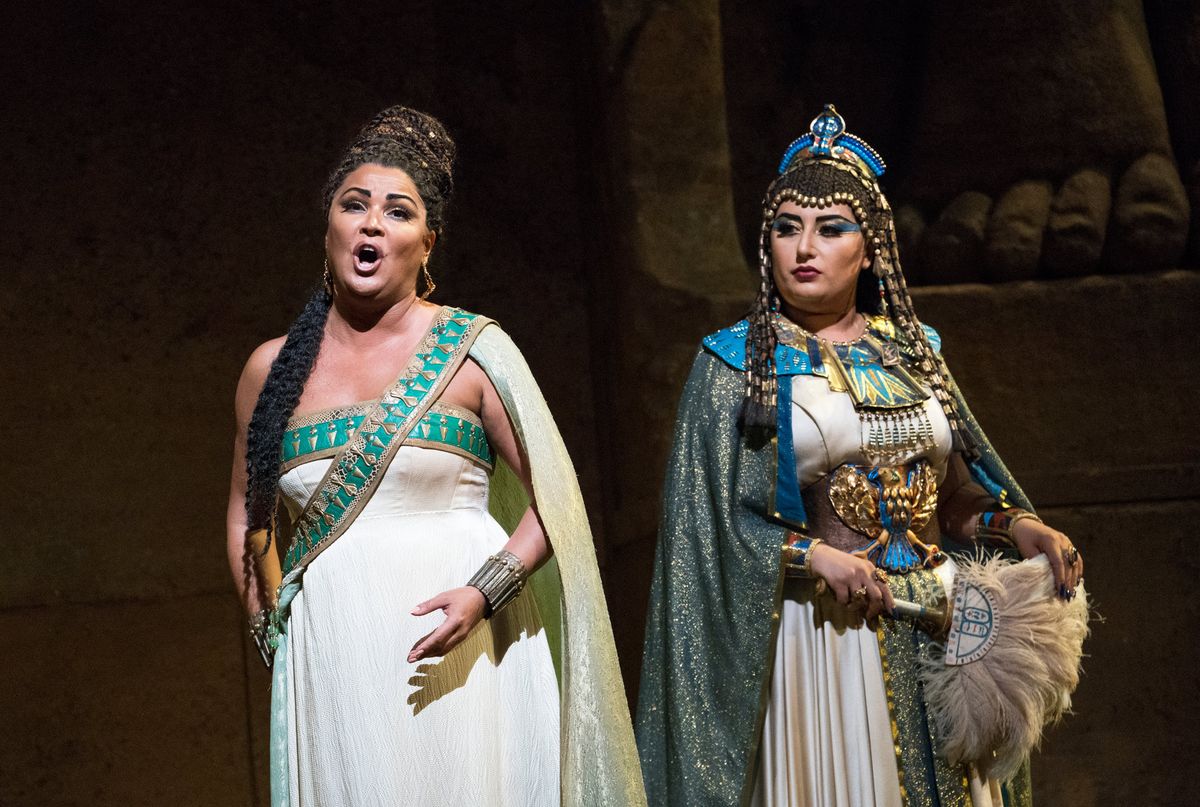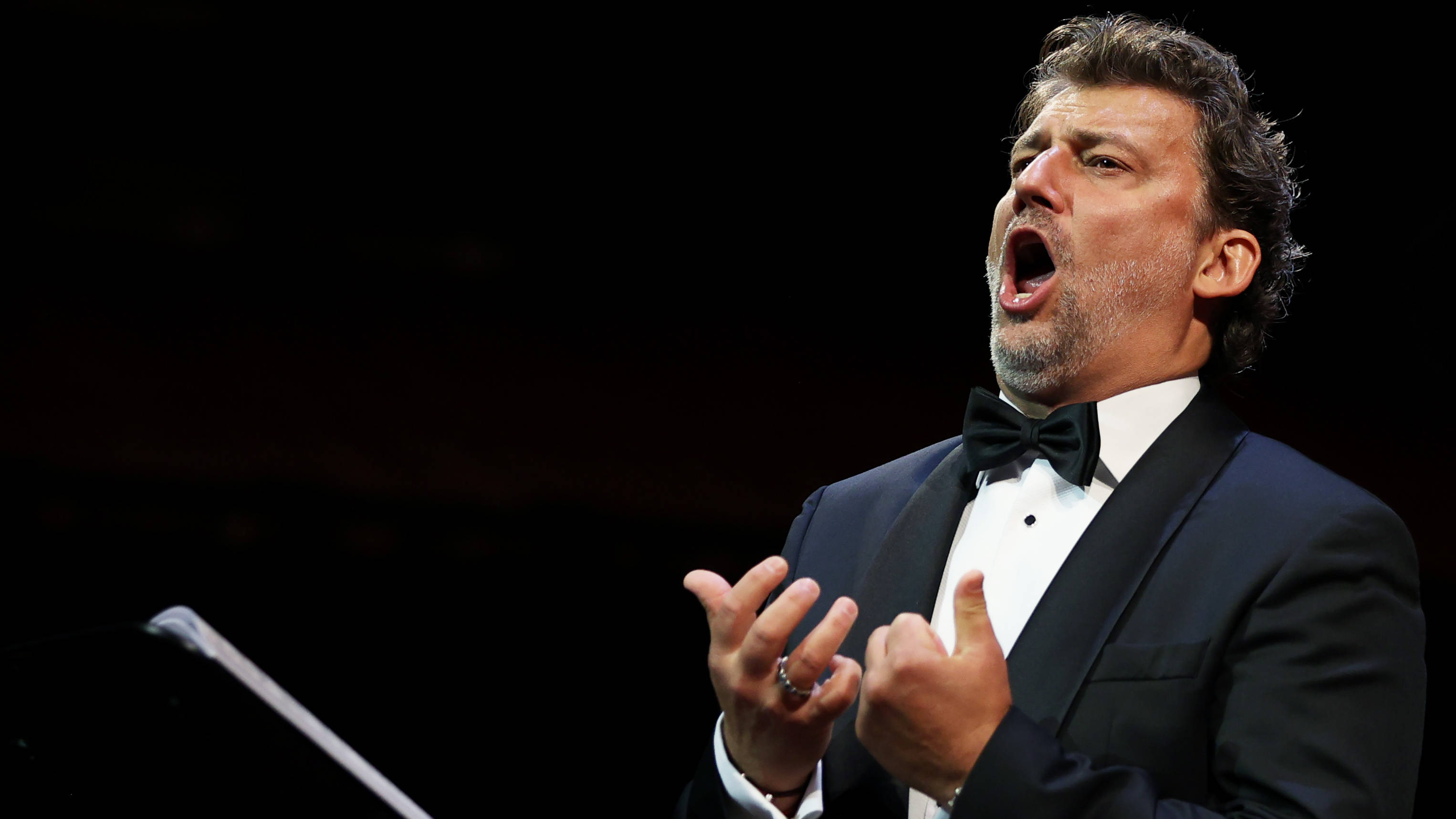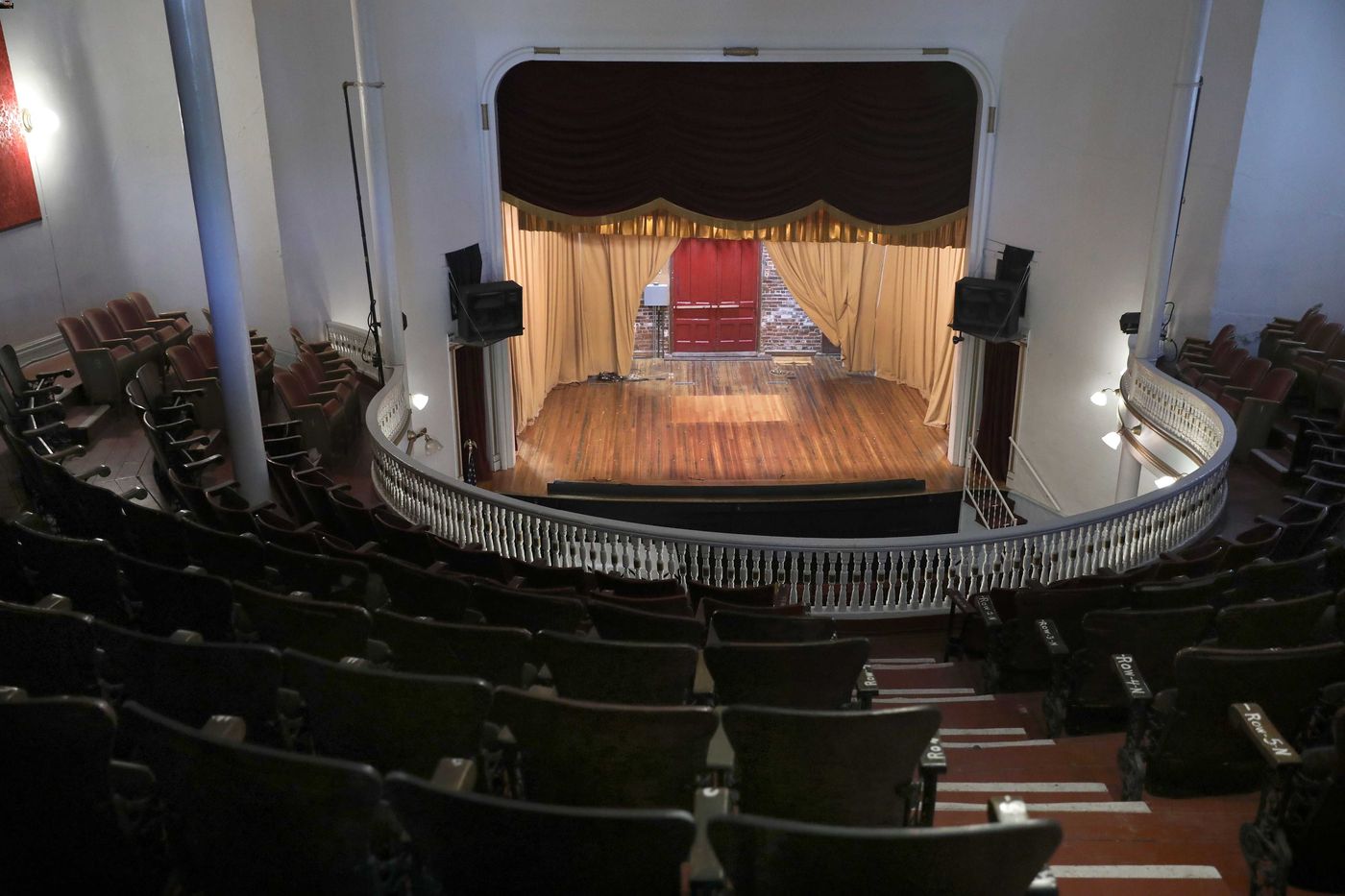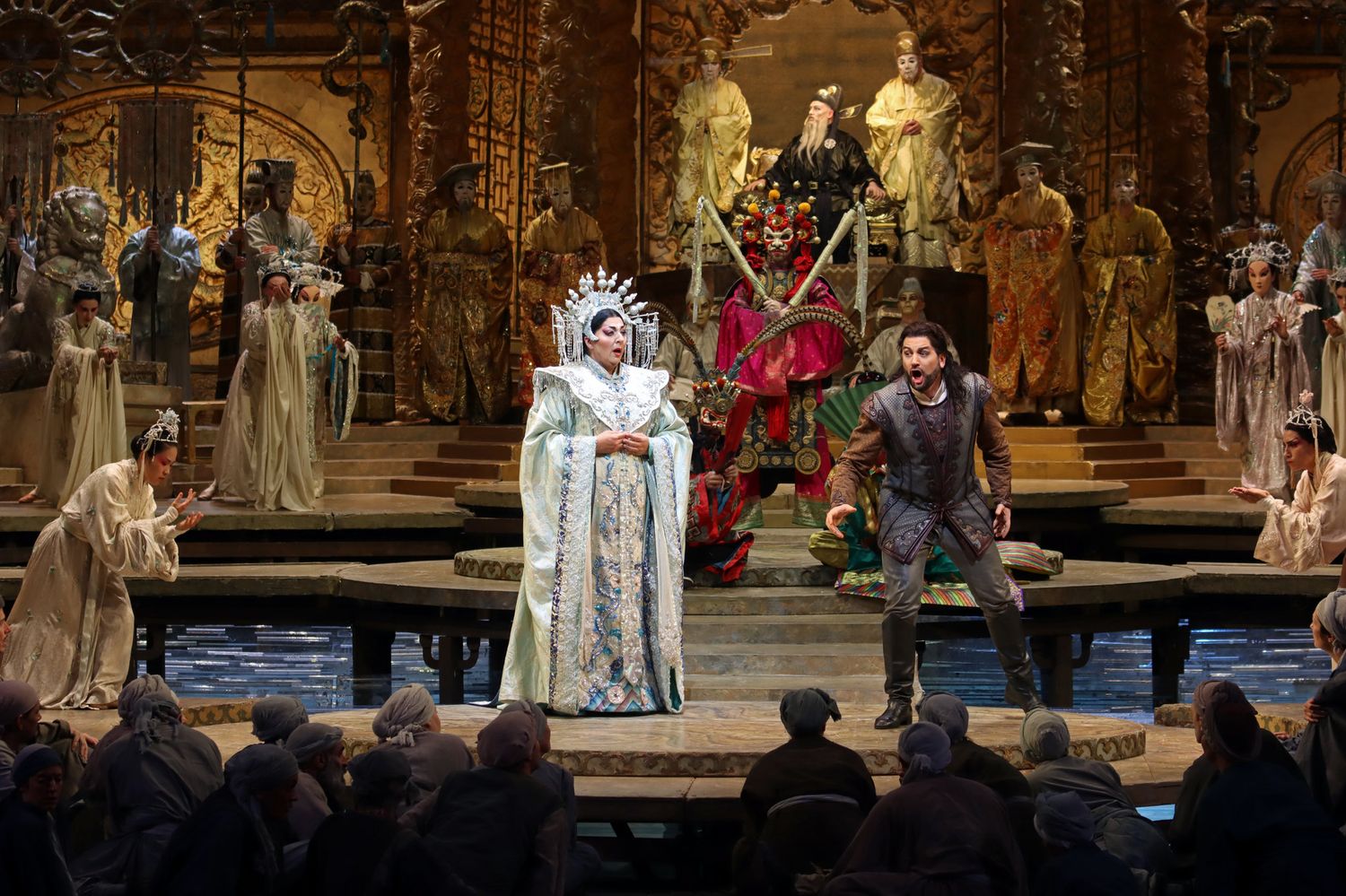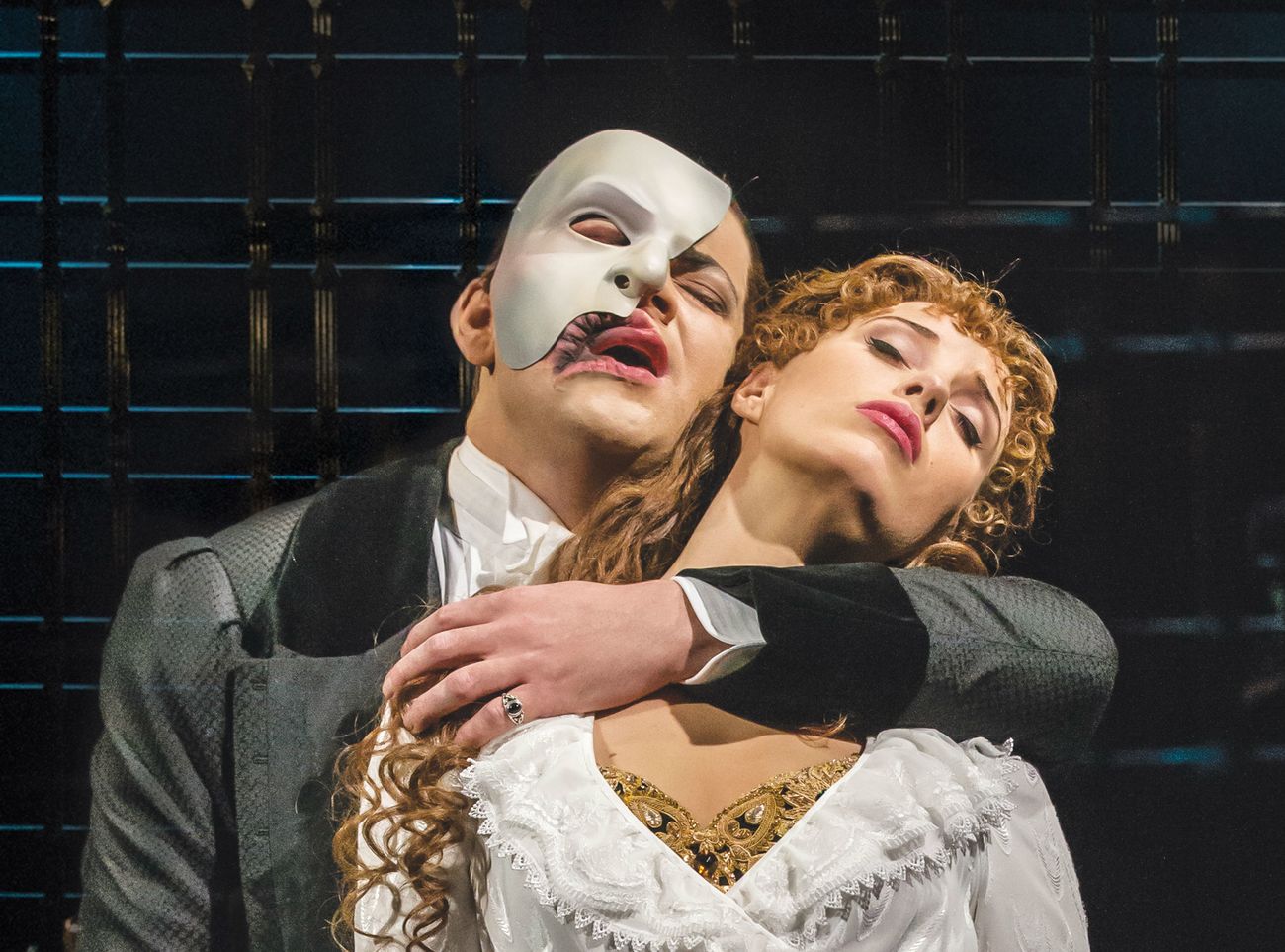Home>Events & Info>Opera>What Is A Opera


Opera
What Is A Opera
Modified: January 22, 2024
Discover the beauty and grandeur of opera with our comprehensive guide. Learn about the history, famous composers, and mesmerizing performances that make opera a timeless art form.
(Many of the links in this article redirect to a specific reviewed product. Your purchase of these products through affiliate links helps to generate commission for AudioLover.com, at no extra cost. Learn more)
Table of Contents
Introduction
Opera is a captivating art form that seamlessly combines music, drama, and visual spectacle to create a powerful and emotive experience. Originating in Italy in the late 16th century, opera has evolved over the centuries and continues to enchant audiences worldwide with its grandeur and storytelling.
At its core, opera is a form of theatrical performance in which the narrative and dialogue are conveyed through sung vocals accompanied by an orchestra. It brings together various artistic disciplines, including music composition, vocal performance, acting, set design, costume design, and choreography, to create a multisensory experience that transcends traditional boundaries.
Opera has its roots in the ancient Greek drama and Renaissance courtly spectacles, but it truly came into its own during the late Renaissance and Baroque periods in Italy. The genre quickly spread across Europe, gaining popularity and undergoing various stylistic changes along the way.
One of the defining characteristics of opera is the use of vocal music to convey the emotions and intentions of the characters. The singers, often referred to as opera singers or vocalists, undergo rigorous training to develop their voices and acquire the necessary techniques to execute complex vocal performances. Their ability to convey the emotions of the characters through their singing is a hallmark of opera and a source of its immense power.
Opera performances are typically held in dedicated theaters or opera houses, with elaborate set designs, costumes, and staging. These elements, combined with the powerful vocal performances and the accompanying live orchestra, create a unique and immersive experience for the audience.
Opera has a rich and diverse repertoire, ranging from classic works by renowned composers such as Mozart, Verdi, and Puccini, to contemporary and experimental compositions. Each opera tells a unique story and explores a wide range of themes, from love and tragedy to politics and social issues.
Throughout history, opera has played a significant role in shaping cultural and social landscapes. It has provided a platform for artistic expression, political commentary, and the exploration of human emotions and experiences. Today, opera continues to thrive as a vibrant and evolving art form, captivating audiences with its timeless stories and breathtaking performances.
Definition of Opera
Opera is a multidisciplinary art form that combines music, drama, and visual elements to tell a story. It is characterized by its use of sung vocals, accompanied by an orchestra, to convey the emotions and intentions of the characters. The word “opera” comes from the Italian word “opera” which means work, indicating the collaborative effort that goes into creating a opera production.
Opera is distinguished from other forms of musical theater by its emphasis on the power of the human voice. The singers, known as opera singers or vocalists, undergo extensive training to develop their voices and master the techniques required to deliver powerful and expressive performances. The music in opera is composed specifically for the singers, often featuring elaborate vocal ornamentation and virtuosic passages.
In addition to the vocal performances, opera incorporates theatrical elements such as acting, stage design, costumes, and lighting. These elements work together to create a visually stunning and immersive environment that enhances the storytelling. The sets and costumes are often elaborate and meticulously designed to transport the audience to different times and places.
One of the defining features of opera is its grandiosity and larger-than-life nature. The music is often grand and sweeping, with dramatic crescendos and emotional climaxes. The stories told in opera are often epic in scale, dealing with themes of love, tragedy, betrayal, and heroism.
Opera can be performed in various languages, although Italian, German, French, and English are among the most commonly used. Subtitles or supertitles are often provided to help the audience understand the lyrics and follow the story.
Opera productions can range from traditional interpretations of classic works to avant-garde and experimental performances that push the boundaries of the art form. Regardless of the style or approach, opera continues to captivate audiences around the world with its powerful combination of music, theater, and storytelling.
Historical Development
The history of opera dates back to the late 16th century in Italy, where it emerged as a distinct art form that combined music and theater. The precise origins of opera are still debated among scholars, but it is commonly traced to the Florentine Camerata, a group of intellectuals and musicians who sought to recreate the dramatic singing of ancient Greek theater.
The first known opera, “Dafne,” was composed by Jacopo Peri and premiered in 1597. It was followed by other pioneering works such as Claudio Monteverdi’s “Orfeo” in 1607, which marked a significant turning point in the development of opera.
In the 17th and 18th centuries, opera spread throughout Europe, with Italy remaining at the forefront of the genre. Opera houses were established in major cities, and composers such as Alessandro Scarlatti, Georg Friedrich Handel, and Christoph Willibald Gluck contributed to its evolution.
The 19th century saw the rise of Romanticism, which had a profound influence on opera. Composers like Giuseppe Verdi and Richard Wagner pushed the boundaries of the art form, exploring complex psychological themes and experimenting with orchestral textures and vocal techniques.
By the 20th century, opera had diversified into various styles and movements. Composers like Giacomo Puccini and Benjamin Britten brought a sense of realism and emotional intensity to their works, while the expressionist and atonal works of Arnold Schoenberg and Alban Berg challenged traditional tonal structures.
The mid-20th century witnessed a resurgence of interest in Baroque opera, with the revival of works by composers like Handel and Monteverdi. At the same time, composers such as Philip Glass and John Adams embraced minimalism and brought a contemporary sensibility to the genre.
Today, opera continues to evolve and adapt to the changing times. Experimental productions, contemporary compositions, and reinterpretations of classical works are all part of the vibrant opera landscape. Opera festivals, competitions, and international collaborations further contribute to its global reach and cross-cultural exchange.
Opera has left an indelible mark on the world of music and theater. Its historical development exemplifies the resilience and creativity of artists who have continually pushed the boundaries of the art form to captivate audiences and express the human condition in new and compelling ways.
Key Elements of Opera
Opera is a complex art form that incorporates various elements to create a cohesive and immersive experience. Understanding these key elements helps us appreciate and analyze the intricate craftsmanship that goes into every opera production.
1. Music: The music in opera is an essential element that sets it apart from other forms of theater. Composers write specific scores for each opera, creating melodies, harmonies, and rhythms that support the drama and emotions portrayed. The music can range from soaring and melodic to dissonant and experimental, depending on the composer’s style and the nature of the story.
2. Vocal Performance: Opera singers, often referred to as opera singers or vocalists, are central to the art form. They undergo rigorous training to develop their voices and master the techniques required to convey the emotions and intentions of the characters through singing. Opera vocalists possess a wide vocal range, enabling them to perform complex vocal passages and hit high and low notes with precision.
3. Libretto: The libretto is the text or script of the opera. It includes the dialogue, lyrics, and stage directions. The librettist, often working in collaboration with the composer, crafts the narrative, develops the characters, and determines the structure and flow of the opera.
4. Acting: Opera combines music and theater, and thus, acting plays a crucial role. Opera singers not only focus on their vocal performance but also strive to bring their characters to life on stage through their acting skills. They use gestures, facial expressions, and body language to convey the emotions and dramatic moments of their roles.
5. Stage Design and Set: Opera productions feature elaborate and intricate stage designs and sets. Set designers create visually stunning environments that transport the audience to different locations and time periods. The sets may include elaborate backdrops, props, and scenery that enhance the storytelling and create a sense of realism or symbolism.
6. Costumes and Makeup: The costumes and makeup in opera are vital for creating the visual identity of the characters. Costume designers carefully select fabrics, colors, and styles that reflect the time period, social status, and personality of each character. Makeup artists use cosmetics and prosthetics to enhance the actors’ features and create visually striking appearances.
7. Orchestra: The orchestra, conducted by a maestro, provides the musical accompaniment for the singers on stage. The orchestra is composed of various instruments, including strings, woodwinds, brass, and percussion. The conductor ensures the synchronization between the singers and the orchestra, creating a harmonious blend of music and vocals.
8. Choreography and Dance: Some opera productions incorporate choreography and dance to add another layer of artistic expression. Choreographers create dance sequences that complement the music and enhance the storytelling. Ballets or ensembles of dancers may be included in certain operas to depict festive celebrations or dance interludes.
These key elements work together harmoniously to create an unforgettable opera experience. They combine to immerse the audience in a world of music, drama, and visual splendor, allowing them to be transported to the heart of the story and connect with the emotions and humanity of the characters.
Types of Opera
The world of opera encompasses a wide range of styles and genres, each with its own distinctive characteristics and cultural significance. From classic Italian opera to contemporary experimental works, here are some of the key types of opera:
- Italian Opera: Italian opera is perhaps the most well-known and influential type of opera. It emerged during the Baroque period and reached its height of popularity in the 19th century. Composers such as Gioachino Rossini, Giuseppe Verdi, and Giacomo Puccini created enduring masterpieces that continue to captivate audiences worldwide.
- German Opera: German opera, particularly associated with the works of Richard Wagner, is characterized by its epic scale and complex musical textures. Wagner’s concept of the “total work of art” (Gesamtkunstwerk) brought together opera, music, drama, and spectacle in a unified and immersive way. His operas, such as “Tristan und Isolde” and “The Ring Cycle,” often explore mythical and philosophical themes.
- French Opera: French opera is known for its elegance, lyrical melodies, and refined style. Composers like Jean-Baptiste Lully, Georges Bizet, and Jules Massenet have contributed to the French operatic tradition. French opera often features elaborate ballet sequences and showcases the French language and cultural sensibilities.
- English Opera: English opera has a rich tradition that dates back to the 17th century. Notable English composers, such as Henry Purcell and Benjamin Britten, have made significant contributions to the genre. English opera often depicts stories of national significance or draws inspiration from literature and folklore.
- Comic Opera: Comic opera, also known as opera buffa or operetta, combines comedic elements with music and storytelling. It often features light-hearted, humorous plots and characters. Famous examples include Mozart’s “The Marriage of Figaro” and Gilbert and Sullivan’s operettas.
- Contemporary Opera: Contemporary opera is a broad category that encompasses new works and experimental compositions. Contemporary opera pushes the boundaries of the art form, incorporating avant-garde elements and exploring unconventional storytelling approaches. Modern composers like Philip Glass, John Adams, and Kaija Saariaho have made significant contributions to contemporary opera.
These are just a few examples of the diverse types of opera that exist. Each type has its own unique characteristics, reflecting the cultural, historical, and artistic contexts in which it was created. Whether rooted in tradition or pushing the boundaries of innovation, opera continues to evolve and captivate audiences with its rich and diverse repertoire.
Famous Operas
Throughout the centuries, opera has produced a wealth of iconic and beloved works that have become cornerstones of the art form. These famous operas showcase the range of storytelling, emotional depth, and musical brilliance found in opera:
- La Traviata: Composed by Giuseppe Verdi, “La Traviata” is a tragic love story based on Alexandre Dumas fils’ play, “La Dame aux Camélias.” It explores themes of sacrifice, redemption, and societal expectations. The hauntingly beautiful music, particularly the aria “Sempre libera,” has made it one of the most frequently performed operas worldwide.
- Carmen: Composed by Georges Bizet, “Carmen” tells the captivating story of a free-spirited and fiercely independent woman who becomes entangled in a web of love, jealousy, and tragedy. The opera features iconic arias such as “Habanera” and “Toreador Song” and offers a vibrant blend of passion, drama, and unforgettable melodies.
- The Magic Flute: Wolfgang Amadeus Mozart’s “The Magic Flute” is a fantastical and enchanting opera that combines comedy, adventure, and the themes of love and enlightenment. It features a diverse cast of characters, including the heroic prince Tamino and the powerful Queen of the Night. The opera’s uplifting music and memorable arias, such as “Der Hölle Rache,” have made it one of Mozart’s most popular works.
- Aida: Verdi’s grand opera “Aida” takes place in ancient Egypt and tells the tragic love story of an Ethiopian princess and an Egyptian military commander. It features monumental choral and orchestral passages, including the famous aria “Celeste Aida.” “Aida” is renowned for its epic scale, dramatic plot, and powerful emotional impact.
- Madama Butterfly: Giacomo Puccini’s “Madama Butterfly” explores themes of love, sacrifice, and cultural clashes. Set in Nagasaki, Japan, it tells the poignant story of a young geisha named Cio-Cio-San and her ill-fated love for an American naval officer. The opera is known for its heartbreaking arias, such as “Un bel dì vedremo” and “Humming Chorus,” which beautifully convey the emotional depth of the characters.
- The Marriage of Figaro: Mozart’s “The Marriage of Figaro” is a comedic opera that satirizes the aristocracy and portrays the complex relationships between the characters. It showcases Mozart’s mastery of writing vocal ensembles and features sparkling melodies and witty dialogue. The opera’s overture and famous arias, such as “Non più andrai” and “Voi che sapete,” highlight Mozart’s genius for blending comedy and charm.
These famous operas represent just a glimpse of the vast repertoire that opera has to offer. Each one showcases the unique storytelling, emotional depth, and musical brilliance that have made opera a timeless art form, captivating audiences across the globe for centuries.
Opera Singers and Roles
Opera singers, also known as vocalists or opera performers, play a vital role in bringing the characters and stories of opera to life. These highly trained artists possess exceptional vocal skills and undergo rigorous training to master the techniques required for opera singing.
Opera roles are diverse, ranging from tragic heroines and heroic tenors to comedic buffoons and powerful villains. The voice types or vocal ranges of opera singers are categorized into several distinct categories:
- Soprano: Sopranos have the highest vocal range among female singers. They can possess light, agile voices (coloratura sopranos) or powerful, dramatic voices (dramatic sopranos). Famous soprano roles include Violetta in “La Traviata” and the Queen of the Night in “The Magic Flute.”
- Mezzo-soprano: Mezzo-sopranos have a slightly lower vocal range than sopranos. They often portray character roles that require depth and complexity. Notable mezzo-soprano roles include Carmen in Bizet’s “Carmen” and Dido in Purcell’s “Dido and Aeneas.”
- Contralto: Contraltos have the lowest female vocal range, often characterized by richness and warmth. They typically portray powerful, dramatic characters. Famous contralto roles include the title role in Handel’s “Julius Caesar” and the role of Ulrica in Verdi’s “Un ballo in maschera.”
- Tenor: Tenors are the highest male vocal range, known for their ability to hit high notes with ease. They often play romantic heroes or noble characters. Iconic tenor roles include Rodolfo in Puccini’s “La Bohème” and the title role in Wagner’s “Tristan und Isolde.”
- Baritone: Baritones have a range between tenors and basses and are known for their versatile voices. They portray a wide range of characters, from romantic leads to father figures or villains. Famous baritone roles include the title role in Verdi’s “Rigoletto” and Don Giovanni in Mozart’s “Don Giovanni.”
- Bass: Basses have the deepest vocal range among male singers. They often perform roles that require exceptional vocal power and resonance. Renowned bass roles include Sarastro in “The Magic Flute” and the title role in Mussorgsky’s “Boris Godunov.”
Opera singers dedicate years to mastering their craft and honing their vocal skills. They undergo intensive training to develop breath control, diction, vocal agility, and interpretation of the music and text. Opera singers often specialize in specific vocal categories or styles, and their voice types determine the roles they are most suited for.
Throughout history, numerous opera singers have achieved legendary status, leaving an indelible mark on the art form. Singers like Maria Callas, Luciano Pavarotti, and Plácido Domingo have become synonymous with excellence in opera, enchanting audiences with their extraordinary voices and captivating stage presence.
Opera singers and the characters they bring to life are an integral part of the magic of opera. Through their talent and dedication, they create the emotional depth and connection that captivate audiences and make opera a truly unforgettable experience.
Opera Productions
Opera productions encompass the collaborative efforts of numerous artists and professionals who work together to bring the magic of opera to the stage. From directors and set designers to costume designers and lighting technicians, each production element plays a crucial role in creating a visually stunning and cohesive theatrical experience.
Stage Design: Set designers are responsible for creating the physical environment and visual aesthetics of an opera production. They collaborate closely with the director to bring the story to life through scenic elements, backdrops, props, and stage machinery. Set designs can range from classic and traditional to avant-garde and abstract, depending on the artistic concept of the production.
Costume Design: Costume designers work closely with the director and set designers to create costumes that reflect the characters, time period, and overall visual style of the production. They consider clothing styles, colors, fabrics, and accessories to establish the visual identity of each character. Costume changes and quick costume transitions are carefully planned to seamlessly convey the story and enhance the characters’ development.
Lighting Design: Lighting designers contribute to the overall aesthetic and mood of an opera production through the strategic use of lighting. They use different types of lighting fixtures, colors, and intensities to highlight specific characters, create atmosphere, and evoke emotions. Lighting plays a critical role in conveying the passage of time, indicating changes in mood, and directing the audience’s attention to key moments on stage.
Stage Direction: Stage directors guide the overall artistic vision and interpretation of an opera production. They work closely with the singers, actors, and other members of the creative team to develop characterizations, blocking, and stage movement. The director’s guidance ensures that the performers’ actions and expressions effectively convey the story and the emotional depth of the characters.
Orchestral Accompaniment: The orchestra, conducted by a maestro, is an essential element of opera productions. The conductor guides the musicians through rehearsals and performances, ensuring that the music aligns with the singers on stage. The orchestra provides the live musical accompaniment, complementing the singers’ voices and enhancing the emotional impact of each scene.
Chorus and Extras: Opera productions often feature a chorus, a group of singers who perform together as a collective entity. The chorus adds depth and richness to the music and can represent various characters or even serve as a crowd. Extras, or supernumeraries, are non-singing actors who take on non-speaking and non-singing roles, adding to the visual and dramatic aspects of the production.
Technical Crew: Behind the scenes, a team of technicians and stagehands work diligently to ensure smooth production operations. They handle set changes, manage props, control audio and visual cues, and oversee the technical aspects of the production, including sound engineering and special effects.
Opera productions bring together the creative vision of various individuals to create a cohesive and immersive theatrical experience. The collaboration of these professionals, along with the talent and dedication of the singers and musicians, transforms the music and narrative into a truly captivating and unforgettable spectacle.
Opera as a Visual and Musical Art Form
Opera is a unique art form that combines the visual spectacle of theater with the emotive power of music. It engages the senses through its stunning visual designs, captivating storytelling, and the enchanting melodies sung by talented opera singers. It is this fusion of visual and musical elements that makes opera a truly immersive and transformative experience for audiences.
Visual Spectacle: Opera productions are known for their elaborate and visually striking sets, costumes, and lighting designs. Set designers create magnificent backdrops and stage elements that transport the audience to different times, places, and imaginative worlds. The costumes, meticulously designed to reflect the characters’ personalities and historical context, add another layer of visual splendor. Lighting designers create mood and atmosphere, using colors and intensities to enhance key moments and evoke emotions. These visual elements combine to create a feast for the eyes and enhance the storytelling aspect of opera.
Emotion and Drama: Music has a unique ability to convey and evoke emotion, and opera harnesses this power to enhance the dramatic impact of the storytelling. The melodies, harmonies, and orchestrations marry with the vocal performances to elicit a deep emotional response from the audience. The characters of opera experience love, despair, joy, and tragedy, and the music amplifies these emotions, allowing the audience to feel and empathize with the unfolding narrative. Through the fusion of music and drama, opera creates a heightened sense of intensity and emotional connection between the performers and the audience.
The Role of Singers: Opera singers are at the heart of the art form, with their exceptional vocal abilities and dramatic interpretation of the roles they portray. They undergo years of training to develop their voices and learn the technical skills necessary to navigate the demanding vocal challenges of opera. The singers’ performances, filled with emotion and expression, bring the characters vividly to life on stage. Their voices soar and command attention, filling the theater with the power and beauty of their musical expressions.
The Role of the Orchestra: The live orchestral accompaniment in opera enriches the musical experience and adds depth to the storytelling. The orchestra provides the instrumental foundation on which the singers’ voices soar. The combination of the voices and the orchestra creates a compelling musical tapestry that immerses the audience in the world of the opera. The conductor guides the orchestra, ensuring that the music aligns seamlessly with the singers’ performances, enhancing the emotional impact of the story.
Opera’s ability to merge the visual and musical arts creates a total sensory experience for the audience. It engages the eyes and the ears, stimulating both intellectual and emotional responses. The visual and musical aspects work harmoniously to transport and captivate the audience, allowing them to be enveloped in a world of beauty, emotion, and storytelling.
Opera and Cultural Significance
Opera holds a significant cultural importance, leaving an enduring impact on society throughout history. It has not only provided entertainment but also served as a vehicle for artistic expression, social commentary, and cultural preservation.
Preservation of Culture: Opera plays a vital role in preserving cultural heritage by showcasing stories, music, and languages from different time periods and regions. Historical operas allow us to explore and appreciate the customs, traditions, and values of past societies. They serve as a window into the cultural zeitgeist of specific periods, providing insights into the social, political, and artistic climates of their time.
Reflection of Society: Opera has often served as a mirror to society, reflecting and commenting on the issues and concerns of the time in which it was created. Composers and librettists have used opera as a platform to address social, political, and moral topics, shedding light on societal norms and challenging the status quo. Opera has tackled themes such as love, power, betrayal, class conflicts, and political turmoil, opening a dialogue and provoking thought among audiences.
Artistic Collaboration: Opera is a collaborative art form that brings together various artistic disciplines. It involves the seamless integration of music, theater, design, and storytelling. The creative process, which involves composers, librettists, performers, directors, designers, and technicians, fosters innovative collaborations and pushes the boundaries of artistic expression. This collective effort leads to the creation of groundbreaking works that resonate with audiences and inspire future artistic endeavors.
International Exchange: Opera transcends borders, bringing together artists and audiences from around the world. Opera companies often collaborate with international talent, showcasing diverse voices, languages, and cultural perspectives. Through international performances, tours, and festivals, opera facilitates a global exchange of ideas, fostering cultural understanding and appreciation.
Education and Accessibility: Many opera companies and organizations work actively to make opera accessible to a wider public. Educational programs, workshops, and community outreach initiatives provide opportunities for people of all ages to learn about opera and engage with its artistic elements. Subtitles and supertitles are often used during performances to make the stories and lyrics more accessible to audiences who may not understand the language being sung.
Economic Impact: Opera also carries economic significance, contributing to the cultural tourism industry and supporting local economies. Opera productions often require a considerable amount of resources, such as hiring performers, designers, musicians, and technical crews, as well as renting performance venues and promoting the productions. Opera houses and festivals attract audiences from near and far, generating revenue and stimulating local businesses.
Opera’s cultural significance extends beyond entertainment, serving as a vessel for artistic expression, cultural preservation, and societal reflection. Through its ability to bring people together, opera continuously enriches our understanding of diverse cultures, fosters dialogue, and inspires us with its timeless stories and enchanting melodies.
Conclusion
Opera is a breathtaking and multifaceted art form that combines the power of music, theater, and visual design to create a deeply immersive and emotionally resonant experience. From its origins in Italy to its global reach today, opera has evolved and adapted, captivating audiences around the world for centuries.
Opera’s key elements, including the sublime vocal performances, intricate stage designs, and compelling storytelling, come together harmoniously to transport audiences to different worlds and evoke a wide range of emotions. The collaboration of talented artists, from opera singers to set designers, brings each production to life, creating a visual and auditory feast for the senses.
Through its renowned works and famous composers, opera has left an indelible mark on the cultural landscape, reflecting societal values and providing a platform for artistic expression and social commentary. Stories of love, loss, passion, and redemption resonate across time and cultures, making opera a truly universal art form.
Furthermore, opera’s cultural significance extends beyond its artistic achievements. It plays a crucial role in preserving cultural heritage, promoting international exchange, and fostering educational programs that make this inspiring art form accessible to all.
As we continue to appreciate and explore opera, we celebrate the dedication and talent of the opera singers, musicians, designers, directors, and countless others who bring their creative visions to life on stage. Their commitment to pushing boundaries and creating transformative experiences ensures that opera remains a vibrant and evolving art form.
In conclusion, opera is a rich tapestry of music, drama, and visual artistry. Its ability to stir the soul and connect people across time and cultures is a testament to its enduring appeal. Whether experiencing a classic masterpiece or embracing a contemporary innovation, opera invites us to be transported, entertained, and deeply moved by the power of the human voice and the magic of artistic collaboration.


